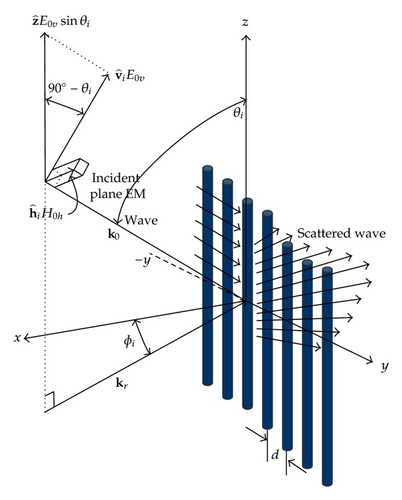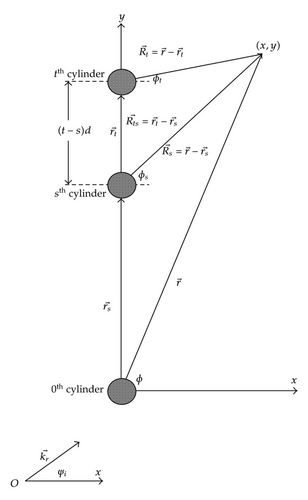Exact Matrix Representation of the Transverse Magnetic Multiple Scattering of Obliquely Incident Plane Waves by the Diffraction Grating of Penetrable Cylinders
Abstract
“An exact matrix conformation model” associated with the equations describing the exact behavior of the Fourier-Bessel multiple scattering coefficients of the diffraction grating consisting of an infinite number of infinitely long parallel penetrable circular cylinders, corresponding to the obliquely incident transverse-magnetic plane waves in “Twersky-Wait-Kavaklıoğlu representation,” originally excogitated in (Kavaklıoğlu, 2000), is acquired, and the exact solution for “the Fourier-Bessel multiple scattering coefficients of the diffraction grating at oblique incidence” is obtained by a matrix inversion procedure.
1. Introduction
Twersky [1] solved the problem of multiple scattering of radiation by an arbitrary configuration of parallel cylinders by the infinite grating of insulating dielectric circular cylinders at normal incidence in terms of cylindrical wave functions as long ago as 1952, considering all possible contributions to the excitation of a particular cylinder by the radiation scattered by the remaining cylinders. He later extended his solution for the case where all axes of cylinders lie in the same plane [2] by expressing the scattered wave as an infinite sum of orders of scattering and derived the solution for the scattering of waves by the finite grating of cylinders [3] at normal incidence. In addition, Twersky introduced a “scalar functional equation” [4] for the grating in order to describe the relationship between the multiple scattered amplitude of the grating in terms of the “multiple scattered amplitude of an isolated cylinder within the grating.” He [5] then utilized the separation-of-variables technique to derive a set of algebraic equations for the “multiple scattering coefficients of the infinite grating” in terms of his famous elementary function representations of “Schlömilch series” [6], and in terms of the “well-known scattering coefficients of an isolated cylinder at normal incidence,” which was originally derived by Rayleigh [7, 8]. His results since then have been reiterated and extensively used by many other authors.
For the more generalized case of conical incidence, Sivov [9] first studied the problem of determining the coefficients of reflection and transmission by an infinite plane grating of parallel conductors assuming the period small in comparison with the wavelength. Lee [10] treated the multiple scattering by an arbitrary configuration of parallel, nonoverlapping infinite cylinders, and provided the solution for the “scattering by closely spaced radially-stratified parallel cylinders with an arbitrary number of stratified layers” [11]. Furthermore, Smith et al. [12] developed a formulation for cylinder gratings in conical incidence using a multipole method in modeling photonic crystal structures and study scattering matrices and “Bloch modes” in order to investigate the photonic band gap properties of woodpile structures [13]. In a more recent study, Henin et al. [14] presented a semianalytical solution by an array of circular dielectric cylinders and parallel-coated circular cylinders of arbitrary radii and positions [15].
The exact equations describing the behavior of the Fourier-Bessel multiple scattering coefficients of an infinite grating of dielectric circular cylinders, which are aligned along the y-axis and parallel to the z-axis, for obliquely incident plane electromagnetic waves, θi being the obliquity angle made with z-axis, were first derived by Kavaklıoğlu [16–18] for both TM and TE polarizations. The generalized representations associated with the reflected and transmitted fields were formulated in terms of these Fourier-Bessel multiple scattering coefficients for obliquely incident plane H-polarized waves in Kavaklıoğlu and Schneider [19]. In addition, they [20] derived the generalized form of Twersky’s functional equation [4] for the infinite grating at oblique incidence in matrix form in terms of the “Fourier-Bessel scattering coefficients of an isolated dielectric circular cylinder at oblique incidence” originally derived by Wait [21]. Moreover, Kavaklıoğlu and Schneider [22] acquired the asymptotic solution for the Fourier-Bessel multiple scattering coefficients of the infinite grating associated with obliquely incident and vertically polarized waves up to and including third order as a function of the cylinder radius to grating spacing when the grating spacing “d” is small compare to a wavelength. Recently, Kavaklıoğlu and Lang [23] demonstrated a rigorous proof for the validity of this asymptotic solution derived in [22].
The purpose of this investigation is to acquire the exact conformation model for the Fourier-Bessel multiple scattering coefficients of an infinite array of penetrable circular cylinders associated with obliquely incident vertically polarized plane electromagnetic waves and to capture the exact representation of the aforementioned coefficients of the diffraction grating at oblique incidence in “matrix form.” In the generalized oblique incidence solution presented in this article, the direction of the incident plane wave makes an arbitrary oblique angle of arrival θi with the positive z-axis as depicted in Figure 1.

In addition, we have explicated and connoted that our proposed method of solution for the scattering coefficients is a new technique and an exact representation. Besides, the paper clearly describes how one can generate a numerical algorithm from this exact solution by the truncation of the system matrices associated with the undetermined multiple scattering coefficients. On the other hand, the objective of this paper is not to discover some numerical algorithm as its title designates, which would be completely approximate and requiring an error analysis.
2. Description of the Transverse Magnetic Multiple Scattering Coefficients of the Infinite Array at Oblique Incidence
We consider a vertically polarized obliquely incident plane electromagnetic wave upon an infinite array of insulating circular dielectric cylinders having infinite length with radii a, dielectric constant εr, and relative permeability μr. The constituent cylinders of the infinite array are placed periodically along the y-axis, with their axis parallel to the z-axis, located at positions r0, r1, r2,…, and so forth, and separated by a distance of d.

3. The Generalized Fourier-Bessel Multiple Scattering Coefficients of the Infinite Grating for Vertically Polarized Obliquely Incident Plane Electromagnetic Waves in Matrix Form
4. Exact Solution to the “Twersky-Wait-Kavaklıoğlu Equations” for an Infinite Grating of Circular Dielectric Cylinders at Oblique Incidence: Transverse-Magnetic Mode
5. Conclusion
In the closely related previous studies, the exact representations of the external fields corresponding to the obliquely incident plane electromagnetic waves and the exact equations describing the behavior of the associated Fourier-Bessel multiple scattering coefficients of an infinite array of penetrable circular cylinders, which are aligned along the y-axis and placed parallel to the z-axis, were derived [16–19] for both TM and TE polarizations. Furthermore, the generalized form of Twersky’s functional equation for the infinite grating at oblique incidence in matrix form was acquired [20] in terms of the Fourier-Bessel scattering coefficients of an isolated dielectric circular cylinder at oblique incidence, which was originally derived by Wait [21]. In a more recent treatment, by the implementation of the Ansatz proposed in [22], the asymptotic solution of the Fourier-Bessel multiple scattering coefficients associated with the obliquely incident and vertically polarized waves has been acquired as a function of cylinder radius to grating spacing up to and including the third order terms when the grating spacing, d, is small compare to a wavelength. In addition, a proof [23] for the validity of the asymptotic solution acquired in [22], have been provided.
In this investigation, we have presented a procedure for acquiring the conformation of the exact equations describing the behavior of the generalized Fourier-Bessel multiple scattering coefficients of an infinite array of penetrable circular cylinders associated with obliquely incident transverse magnetic plane waves in matrix form. This exact representation is formulated in terms of the multiplication of the two (∞ × ∞) system matrices, and describes the exact solutions associated with the transverse magnetic multiple scattering coefficients at oblique incidence. Approximate expressions for the aforementioned multiple scattering coefficients can then easily be acquired by truncating these (∞ × ∞) system matrices.




